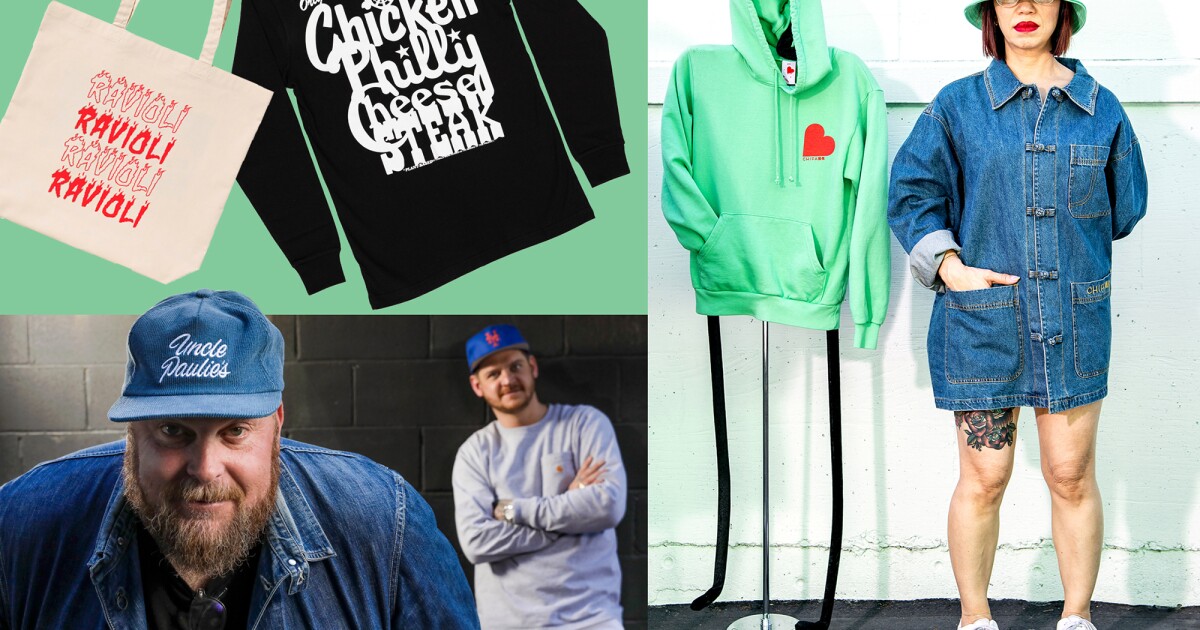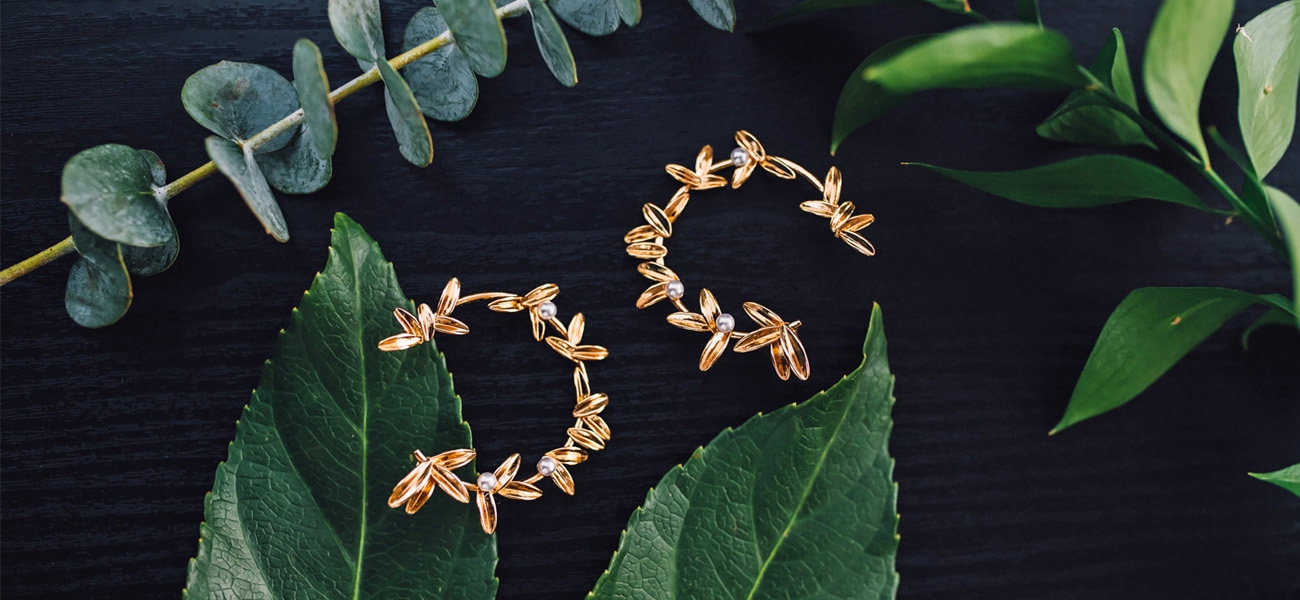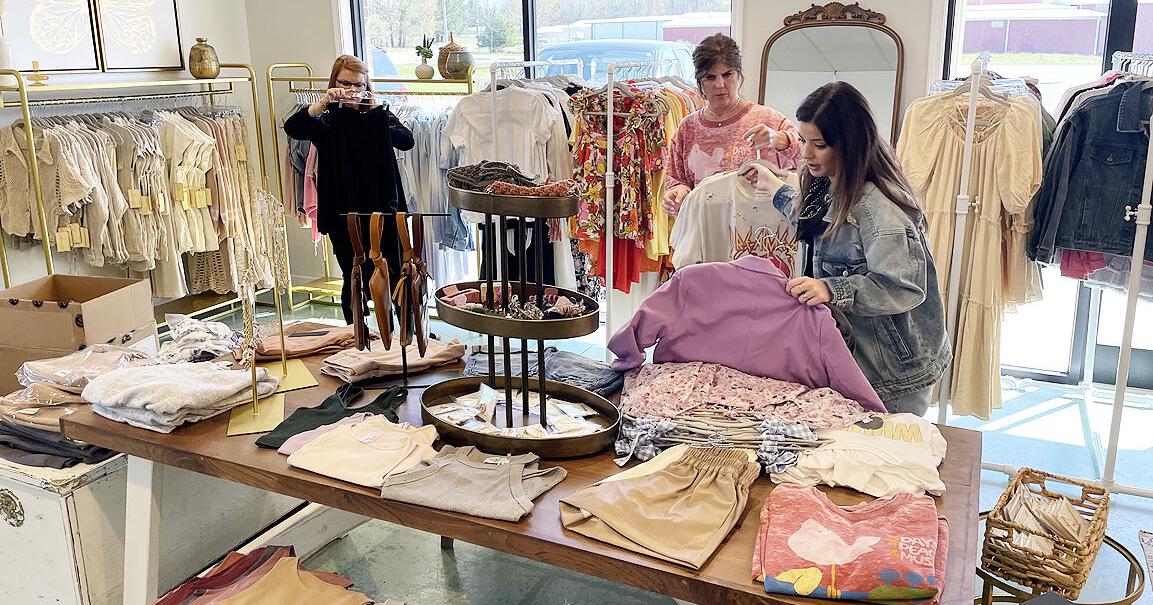The marquee of the former Silent Movie Theater on Fairfax Avenue always displays film titles, but every so often, the sign might read, “The Salsa District” or “Food Flea.” It’s a clue to what’s inside: Brain Dead Studios, the now experimental, experiential theater and retail operation from apparel brand Brain Dead, and Slammers, one of the city’s best cafes. It’s just one of many businesses in L.A. merging food and fashion.
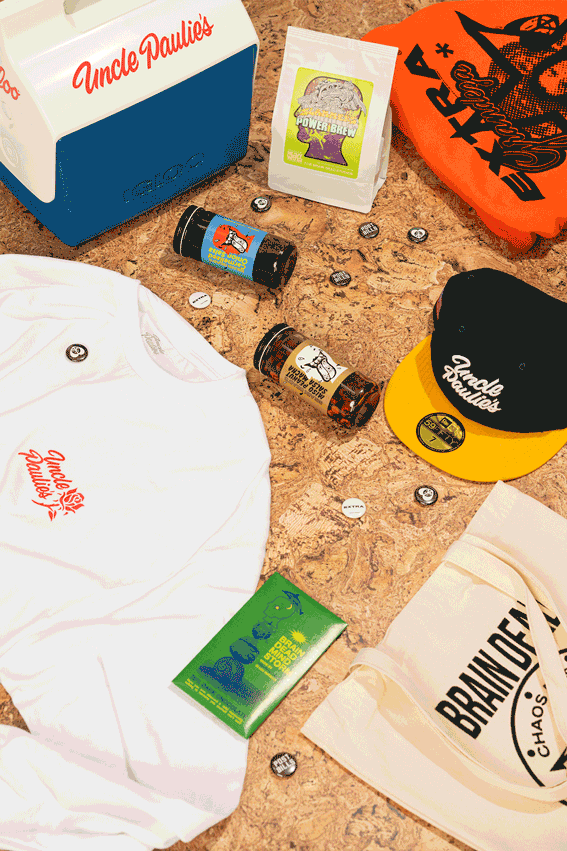
Merch from Brain Dead, Uncle Paulie’s and Extra Market.
(Rebecca Peloquin / For The Times)
At the shop upstairs, rows of Brain Dead-branded, limited-run salsas — a collaboration with pop-up Metztli Taqueria — and jars of a new mole seasoning made with local fermentation outfit Sunset Cultures, line shelves alongside Brain Dead-branded enamelware mugs, tees, sneakers and tennis apparel. The food products are curated by Jesse Furman, the former Grá chef tapped to lead the brand’s culinary arm. At Slammers, on the back patio, Furman’s menu includes onigiri stuffed with gourmet tuna conserva and yuzu kosho mayo; it’s shaped like “logo head,” the Brain Dead brand’s icon.
“I’m re-creating what it means to have a business,” says Furman, who organizes the brand’s food collaborations, cafe menu and culinary events, including a monthly food flea market. “The food is a thank you to people coming to the building, but also I want to be sure Slammers can be seen on its own as well. It’s an interesting marriage.”
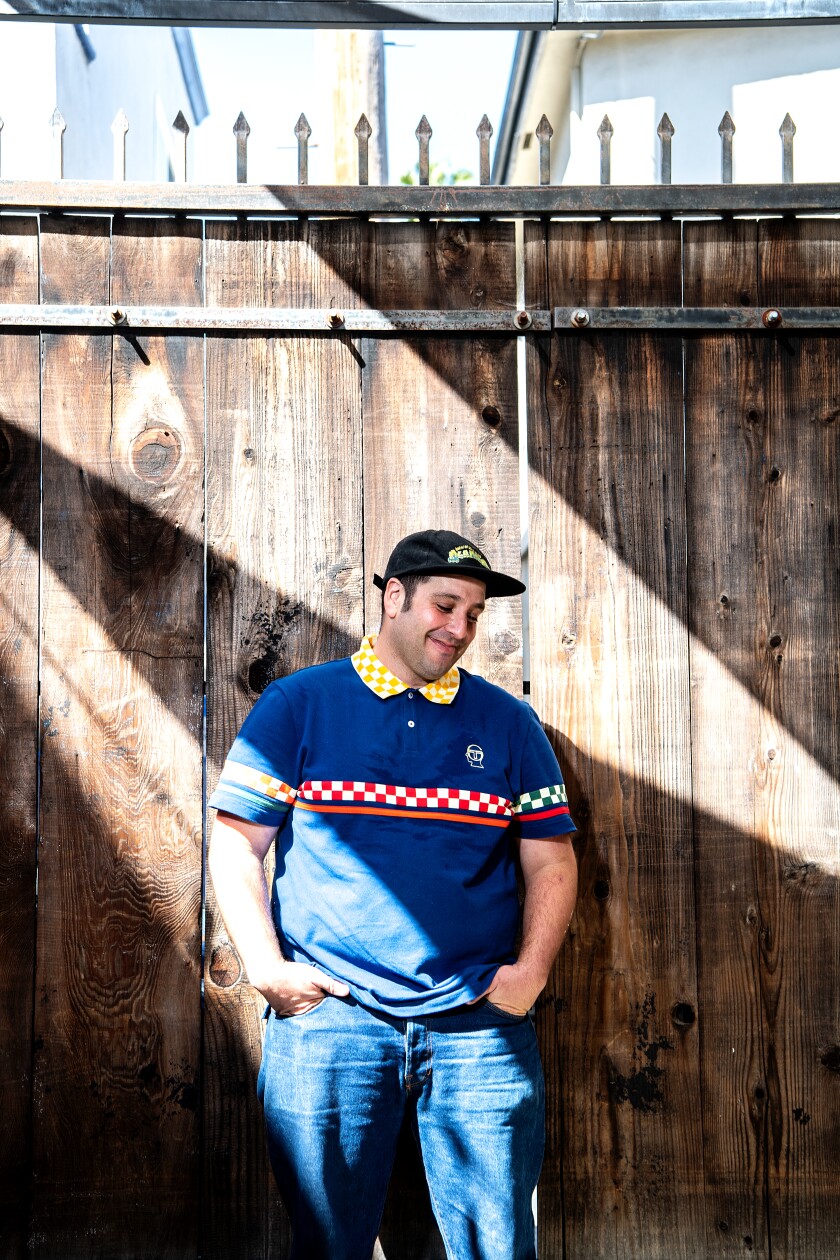
Chef Jesse Furman of Slammers Cafe aims to extend the Brain Dead brand.
(Mariah Tauger / Los Angeles Times)
The Hundreds, a highly influential streetwear brand a block south on Fairfax, produces the annual Family Style Fest, which links local restaurants with major design brands to create one-day-only collaborative merchandise and dishes. Two doors down, fashion designer Jamie Story (alias J. Money) flips plant-based burgers and vegan chili cheese fries at his restaurant, Extra Market, where he runs a gallery behind the eatery and sells his tees up front. Across the street, Jon & Vinny’s, stocked with its own line of merch year-round, is collaborating with apparel brand Madhappy on a capsule collection for the restaurant’s fifth anniversary.
The ties between fashion and food in L.A. extend far beyond Fairfax. In Eagle Rock, Humberto Leon — a co-founder of the international fashion brand Opening Ceremony — serves Chinese and Taiwanese dishes at Chifa, where the restaurant’s design, merch, staff uniforms and even cuisine are notable for their style.
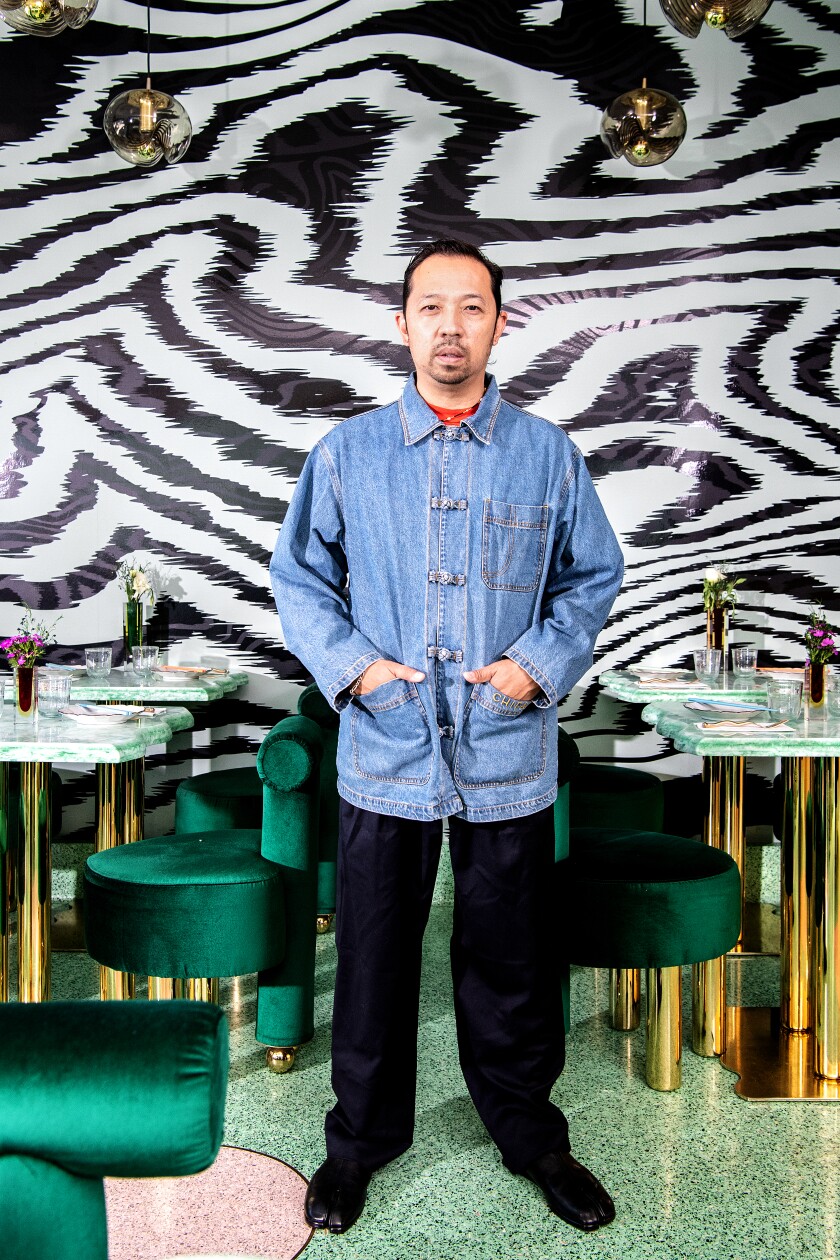
Chifa co-owner Humberto Leon, in the restaurant, wears the denim smock designed for his staff.
(Mariah Tauger / Los Angeles Times)
Designer and sneaker head Jon Buscemi partnered with longtime friend and fashion marketing expert Paulie James to launch sandwich shop, Uncle Paulie’s (now with locations in downtown L.A., Studio City and 3rd Street), where the snapbacks, tees and sweatshirts draw long lines and inspire Pete Davidson and other celebrity customers. DTLA chef Josef Centeno of Orsa & Winston and Bar Amá hand-dyes fabrics using rhubarb, gardenia fruit and other natural ingredients for his small-batch clothing line, Prospect Pine. Nearby, international high-fashion retailer Dover Street Market’s Arts District location houses an outpost of the Anglo-Franco cafe Rose Bakery, where shoppers can pause for seasonal toasts and tea cakes.
At Gucci in Beverly Hills, intricate tasting menus are served on the fashion house’s signature Herbarium plates at the store’s freshly minted Michelin-starred osteria. In a Sunset Strip parking garage, fashion brand Kith’s L.A. shop sells cereal-blended milkshakes and soft-serve cups with flavors designed by the likes of rapper and TV host Action Bronson under an arty installation of all-white Air Jordan 6 Retros (and to echo the title of Bronson’s show, “F—, That’s Delicious.”).
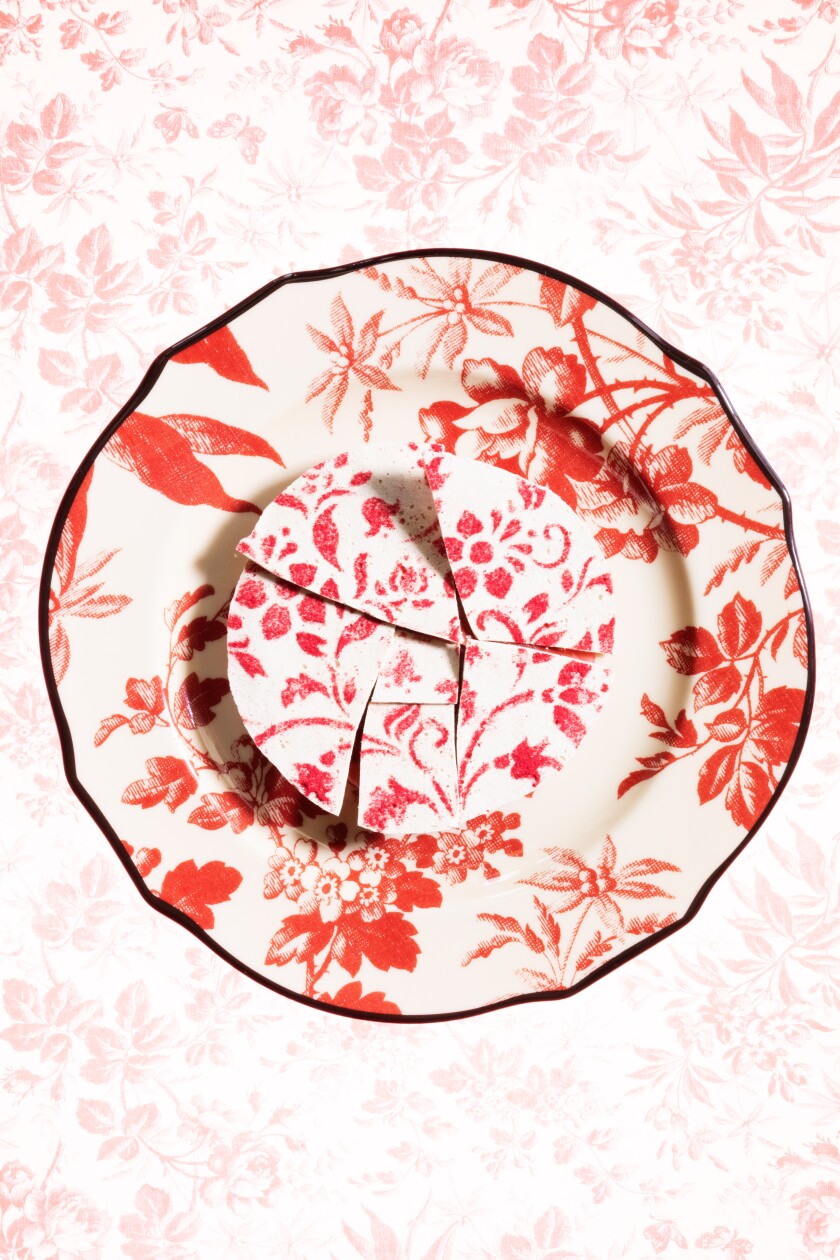
Oops I Broke the Meringue at Gucci Osteria.
(Gabriele Stabile / Gucci)
National brands have been collaborating for years — Telfar and White Castle, David Chang and Nike, to name a couple — but in the last five, it feels as though it’s reached a fever pitch. The urge to blur lines may best be exemplified by collaborations between streetwear and indie restaurants. And to many, it’s not just about marketing: Food and clothing speak to identity, and for a certain demographic, there’s an expectation of a multisensory experience that ignores the traditional boundaries between T-shirts and turkey sandwiches.
Some see it as an evolution.
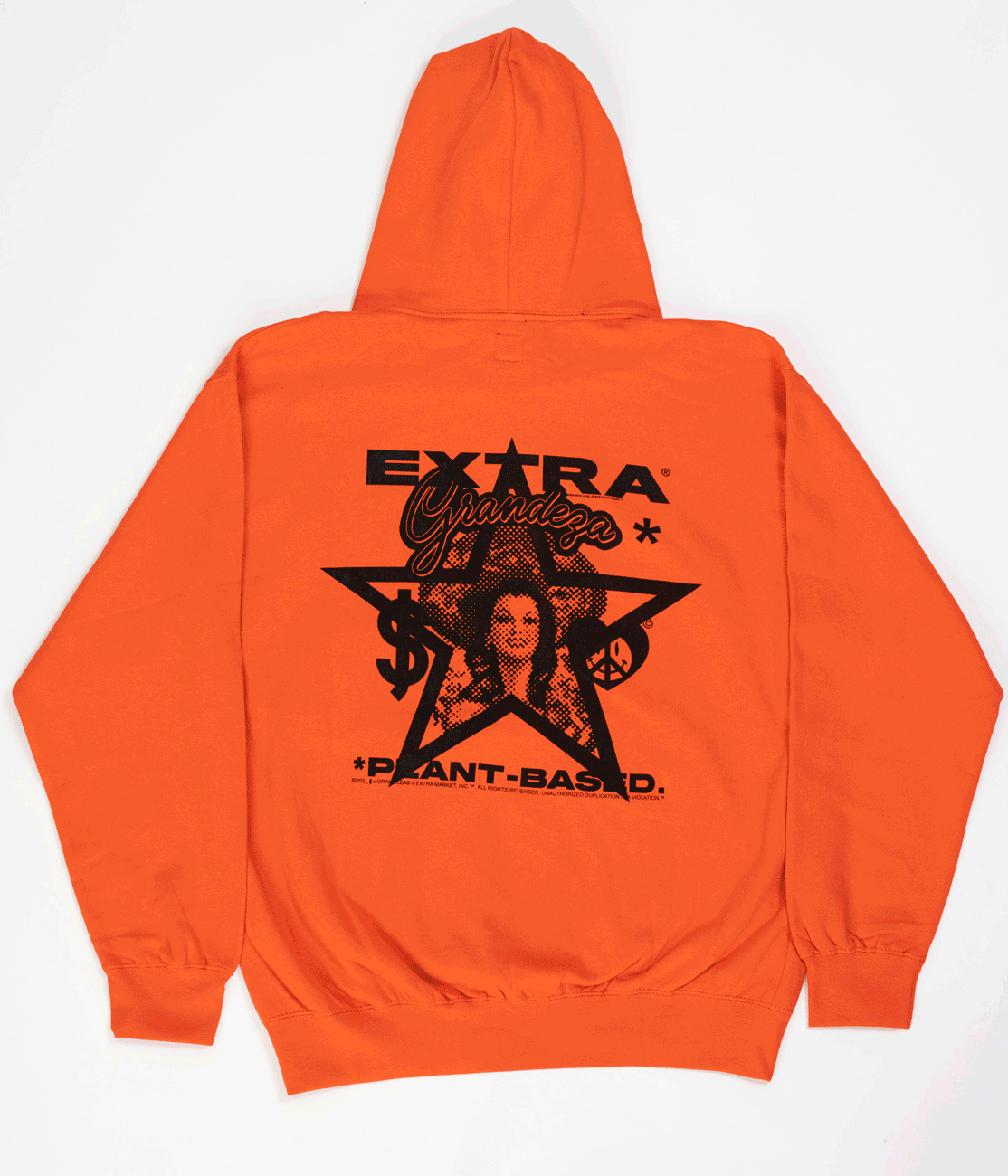
Hoodies from Uncle Paulie’s and Extra Market.
(Rebecca Peloquin / For The Times)
Twenty years ago, designers were collaborating with musicians, James points out. The pairing with food, he adds, was a “natural progression.” “Streetwear had its moment, and a lot of it’s been done, so [this is] a new kind of outlook on it,” he says.
James says he opened a restaurant to leave the fashion marketing industry behind, but the success of the Uncle Paulie’s merch line has pulled him back into it. He and Buscemi began simply with a shirt and a hat. The designs immediately took off, and the owners began offering a rainbow of colors, materials, collab designs and limited-run items, including branded totes, lighters, cutting boards and Igloo coolers. Now, he says, he spends his days checking mentions and photo tags on Instagram, coordinating the next merch drop, the next collaboration.
Now looking at the fashion world from a restaurateur’s perspective, he says every food operation should offer a shirt and a hat: “It’s a walkin’ billboard.”
So how did we get here, a point where Crocs that look like Kentucky Fried Chicken drumsticks can be purchased for more than $200 on the secondary market?
The fusion of food and fashion had been going on for decades before the streetwear boom (the House of Dior even published a cookbook in 1972). But in the last few years, the timeline it’s grown extensively. In 2014, Moschino creative director Jeremy Scott released a playful, irreverent McDonald’s-inspired collection that spurred think pieces and speculation about lawsuits in addition to outcries from health authorities that the high-low release glorified unhealthful eating: The line turned heads with bright red sweaters stitched with a yellow “M” that transformed the golden arches into more of a heart, a purse with a similar motif (carried down the runway on a plastic tray) and a French fry-shaped phone case that helped popularize oversize, cartoonish phone cases for years to come.
In 2016, Dolce & Gabbana teamed up with cooking-appliance company Smeg to produce ornate Italian kitchenware: The five-burner stoves can currently be purchased for just over $10,000; the blenders, electric tea kettles and juicers are $650 apiece, while the hand-painted refrigerators can run as much as $50,000. The following year, the luxury house not only sent a string of models down the runway in food-themed attire (including a covetable cannoli dress) but it also released a line of rebranded, reimagined Di Martino dried pastas, which can be purchased on Instacart and at Neiman Marcus.
In 2020, streetwear brand Supreme launched a collab with Nabisco, producing an Oreo in the clothier’s signature red stamped with “Supreme.” The three-packs, at $8, sold out in minutes and spurred a third-party resale market generally asking upward of $1,000 a pop. One pack, according to Forbes, sold on eBay for more than $92,000.
For Leon, who wove food into social events at Opening Ceremony, the confluence kicked into high gear with the proliferation of social media, the source of FOMO and the great equalizer of enviable experiences. “Social media tells [the world] what you accessed,” he says. Whether it’s a rare pair of sneakers or a bagel from a batch of 100, the social clout makes them “of equal value — they might as well have cost the same price.”
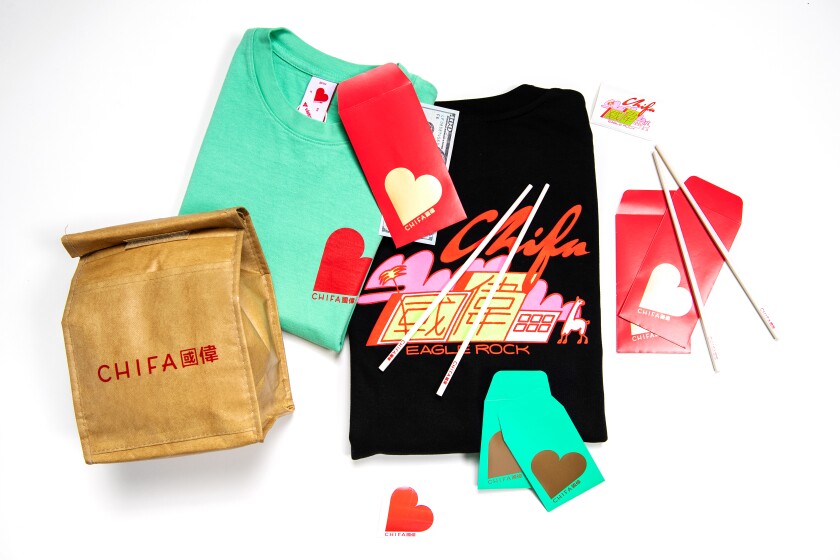
(Mariah Tauger / Los Angeles Times)
With Chifa, Leon has created one of the city’s most social-media-friendly restaurants. Its aquamarine walls, wavy tablescapes and flower-dotted dishes are a colorful and photo-ready means to explore fashion and style, and a haven for collaborations with pastry chefs, painters and other clothing designers. He’s further explored the link with his own collaborations, rolling out limited-run restaurant merch, Sweet Saba’s collection of edible-jade jewelry, Charlie Mai’s style-oriented modern takes on classic Chinese figurines and desserts such as a Peruvian-meets-Chinese purple jelly ear of corn by haute confectioner Lexie Park of Nünchi. Leon designed the denim smocks worn by staff; they’re also available for purchase.
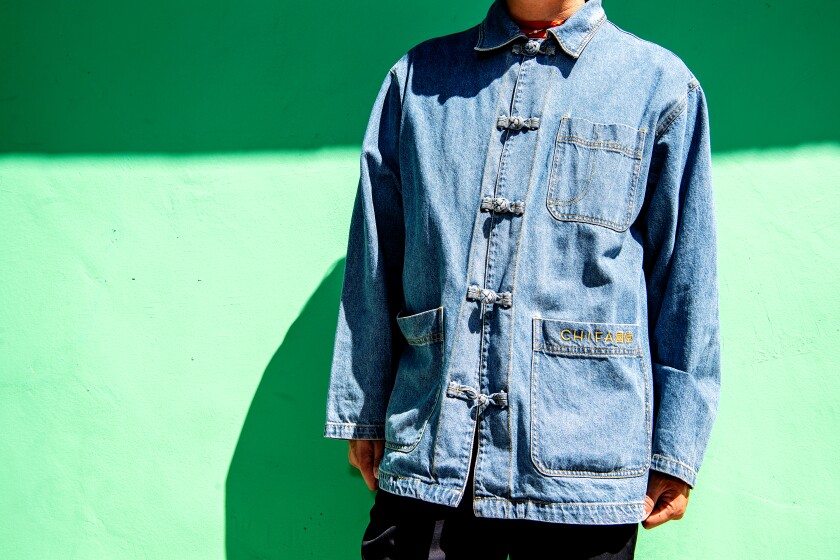
Humberto Leon wears the denim smock designed for his restaurant, Chifa.
(Mariah Tauger / Los Angeles Times)
The items sell quickly both online and in store, prompting — at least once — a friendly tiff among customers at different tables trying to get the last of the jade jewelry. “The person who’s lining up for food is also lining up for a sneaker,” Leon says, “so I think: ‘Why shouldn’t they exist together?’”
It’s easy to see the parallels between the drop culture inherent to limited-run releases, specifically streetwear — drawing hours-long lines for tees, skateboards and more — and the elusiveness of one-night-only menus, specials, chef collabs and food pop-ups. But Ben Shenassafar, co-founder of the Hundreds, sees the appeal in simpler terms: When it comes to the allure of food and fashion, people want to rep their favorite restaurants.
“I think that restaurant merch is the new band merch,” says the food-obsessed Shenassafar, who recently announced his own food and travel Tastemade TV show, “Big Appetite.” “I have a huge collection of T-shirts, and when I travel, if I find a restaurant I really [like], I definitely buy a T-shirt from them. … I think people are very proud of going to a restaurant, buying the T-shirt, very similar to going to a Kanye West concert and buying a T-shirt.”
For Shenassafar and the Hundreds co-founder Bobby Kim, the message on a graphic tee has always been about marketing and building awareness. Since 2019, they’ve helped restaurants spread their own messages through Family Style Fest. One year, Evan Funke’s Venice trattoria Felix linked with the Hundreds to produce a five-panel cap that centered the restaurant’s signature “F” in the brand’s iconic bomb logo. Another year, Blondie Beach designed a tee for Dulan’s sporting an image of the restaurant’s soul-food plate, labeled with the precision of an anatomy textbook.
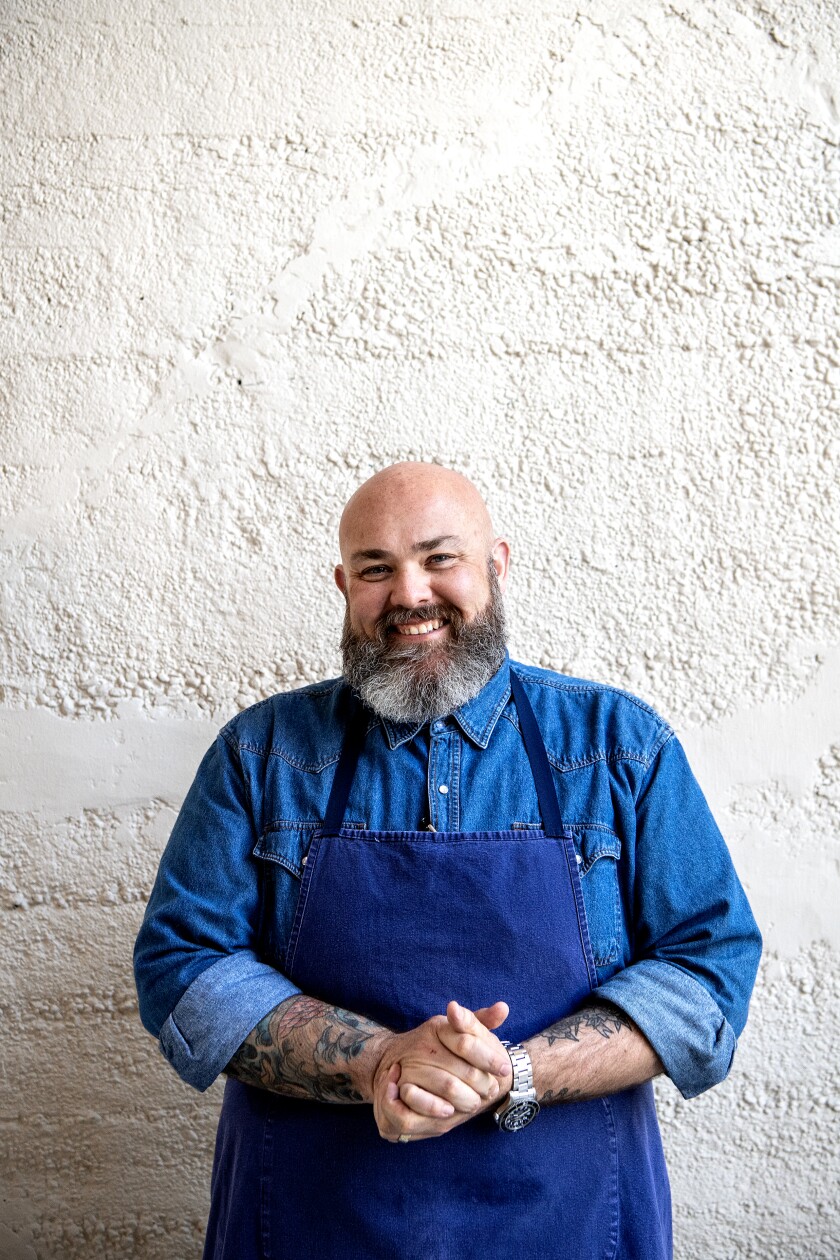
Evan Funke.
(Mariah Tauger / Los Angeles Times)
To Shenassafar, the collaboration presents a symbiotic relationship for brands and restaurants, and it’s just getting started. “It’s not just streetwear: I think it’s fashion in general,” he says. “I think that apparel, fashion, clothing companies working with restaurants and food vendors are just a part of the ecosystem now.”
At Gucci Osteria da Massimo Bottura, with locations in Beverly Hills, Tokyo, Seoul and Florence, Italy, the relationship between food and fashion is less symbiotic and more synergistic. There, the dining room is draped in Gucci wallpaper, the banquettes in deep red velvet and the staff in Gucci-designed uniforms. Dishes from conceptual tasting menus are served in custom red crockery. The burger arrives in a signature Gucci-pink box, the steakhouse-cut fries sprinkled with chicken-skin salt in a Gucci-pink paper sleeve. Gucci’s creative director, Alessandro Michele, curated the design for the spaces; Massimo Bottura, one of the world’s most lauded chefs, and Mattia Agazzi, the Beverly Hills store’s executive chef, Mattia Agazzi, approach the food program with the same eye for detail as Bottura’s childhood friend Marco Bizzarri, the president and chief executive of Gucci.
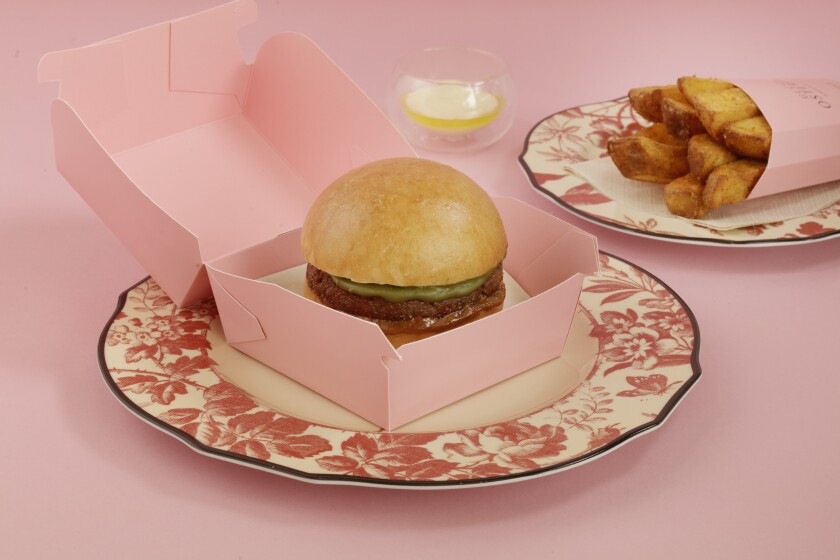
Gucci Osteria’s Emilia burger and patatine fritte are served on its designer plates.
(Gabriele Stabile / Gucci)
Perhaps that’s the future of the broader fusion: total cohesiveness, not so much a meeting point for two concepts but a place where it’s impossible to discern where food begins and fashion ends.
Back at Brain Dead on Fairfax, Jesse Furman considers what it means to be a restaurant, what it means to be a lifestyle brand and how these things can exist together in the years ahead.
“Of course, we’re going to sell T-shirts. Of course, we’re going to sell apparel, but we really want to do much more,” he says. “We’re trying to introduce this food world to people who might not necessarily be a part of that. I’m trying be very inclusive but at the same time be like, ‘This is what I’m into, I hope you enjoy it.’”

Brain Dead merchandise.
(Mariah Tauger / Los Angeles Times)

Slammers Cafe is part of Brain Dead Studios’ complex on Fairfax.
(Mariah Tauger / Los Angeles Times)
Either way, he says, we can all expect more: a Brain Dead-branded chili cook-off, more packaged-food collaborations, maybe a food-and-culture zine, a rollout of the culinary program across Brain Dead’s other locations. You’ll have to keep your eyes peeled, though; the food drops, just like the brand’s merch, disappear as quickly as those logo-head onigiri.

